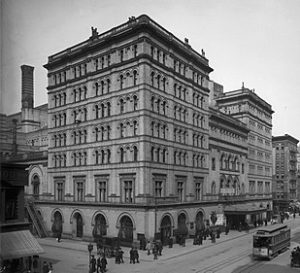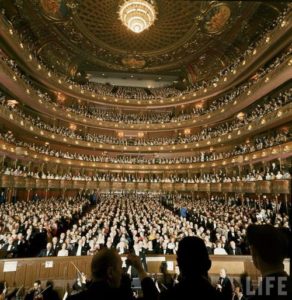A week ago Saturday, my clock radio turned on at six as usual set to the classical music station. After listening to the five-minute news and weather report, I decided to relax in bed and listen to the beautiful melodies of the Masters for a while before beginning my day. About ten minutes into the broadcast the program host announced that later in the hour he would be giving away two tickets to “Met at the Movies”—the opera to be performed was Bizet’s Carmen. It sparked the memory of my first experience.
 The year was 1953. I was thirteen and in the eighth grade. At the time, my father’s long time secretary, Dorothy Kaplan, was retiring. She and her husband David were opera enthusiasts and had season subscriptions to the Metropolitan Opera. Their seats were in the upper balcony, where they could hear the music, but needed strong binoculars to see the action on the stage. As a parting gift in appreciation for her years of service, Dad decided to treat them to box seats for a performance of Carmen, and my mother, sister and I were invited to complete the party.
The year was 1953. I was thirteen and in the eighth grade. At the time, my father’s long time secretary, Dorothy Kaplan, was retiring. She and her husband David were opera enthusiasts and had season subscriptions to the Metropolitan Opera. Their seats were in the upper balcony, where they could hear the music, but needed strong binoculars to see the action on the stage. As a parting gift in appreciation for her years of service, Dad decided to treat them to box seats for a performance of Carmen, and my mother, sister and I were invited to complete the party.
My father gave us a quick lesson on what to expect. The opera would be sung in French, but the plot took place in Spain. The title character was a gypsy girl who worked in a cigarette factory and got into trouble for her actions. In my naiveté, I thought that was because she smoked. The role would be sung by soprano Reese Stevens, and the part of Don Jose by tenor Jan Peerce. We also listened to the LP recording so we would be familiar with the music.
 At the time, the Metropolitan Opera House was located on Broadway and occupied the entire block between West 39th and West 40th Streets in midtown Manhattan. Although the building had an industrial looking exterior, the interior was breathtakingly beautiful with sunburst chandeliers, ornate carvings, red velvet upholstery and gold damask curtains across the stage.
At the time, the Metropolitan Opera House was located on Broadway and occupied the entire block between West 39th and West 40th Streets in midtown Manhattan. Although the building had an industrial looking exterior, the interior was breathtakingly beautiful with sunburst chandeliers, ornate carvings, red velvet upholstery and gold damask curtains across the stage.

Our seats in the Dress Circle gave us a wonderful view of all the action not only on stage, but throughout the theater. The matinee performance was sold out, and everyone was dressed in their very best—gentlemen in suits and ladies in stylish dresses accessorized with coordinating hats and gloves. We too were suitably attired.
The atmosphere was exhilarating, and I felt very grown up to be part of it. Although I didn’t understand the words, I was able to follow the story through the music and the action. The sets and staging were spectacular, the large cast animated, and the costumes colorful. It was an awesome experience that I remember vividly to this day.
Half an hour later, my reverie was interrupted by the announcer saying that the tickets would be awarded to the fifth caller. I figured I’d give it a try. At first I was afraid I had called too quickly and would be one of the first callers; then it rang several more times, and I was afraid I was too late; but he answered by saying: Congratulations! you’re caller number five. WOW, I won! He took my name and contact information and said the tickets would be sent to me via email. It would be interesting to compare my recollections to the current venue and experience.
The opera was first performed in Paris in 1875 where it shocked and scandalized its audiences, but has since become one of the most popular and frequently performed operas in the classical canon. The Habenera from Act 1 and the Toreador Song from Act 2 are among the best known of all arias. The composer died suddenly after the 33rd performance, unaware that his work would achieve international acclaim.
The original Metropolitan Opera House we attended, now referred to as “the old Met,” opened in 1883 with a seating capacity of 3,625 and 224 standing room places. While the theater was noted for its excellent acoustics and elegant interior, its backstage facilities were inadequate for a large opera company. Scenery and sets were a regular sight leaning against the building exterior where crews had to shift them between performances. The old house was closed in April. 1966. A campaign to preserve the theater failed. It was unable to obtain landmark status and was razed in 1967.
The event I attended last weekend was broadcast live from the current Metropolitan Opera House at Lincoln Center on the Upper West Side, with a seating capacity of approximately 3,800—the largest repertory opera house in the world—to movie theaters in seventy countries and more than 350,000 viewers. We sat in large comfortable recliner seats and enjoyed refreshments as we watched.
Due to modern technology we were able to see the performance and the entire theater from many vantage points on a giant screen. There were wide-range shots and close-ups; at times it felt as though we were actually on stage and part of the action. Between acts the cameras also allowed the audience to witness what was going on behind the scenes; and interviews with the performers gave an insight into their personalities and a perspective on the characters they portrayed. All added greatly to our enjoyment as we felt engaged and included rather than being just spectators.
Although my tickets came at no charge, the cost is usually $25 per seat. I don’t know what my father paid for the tickets in 1953, but comparable tickets today would have been $495 each. The one noticeable negative difference was that the audience in New York was dressed casually as though they were going to a sporting event. Elegance and formality were missing. However the excellence and excitement were as entrancing as my first experience, and the modern accoutrements gave me a greater appreciation of the art.
I was honored to be included in watching the afternoon performance. Thank you again. /crt
Have enjoyed many operas at Cinemark Tinselttown over the past 10 years.
Romeo and Juliet, Othello, La Traviata, Carmen, Aida, Tristan and Isolde are only a few of our favorites. I believe “The Ring Cycle” with its four operas: Das Rheingold, Die Walküre, Siegfried and Gotterdämmerung was outstanding.
The performances by Divas and Divos are unbelievable.